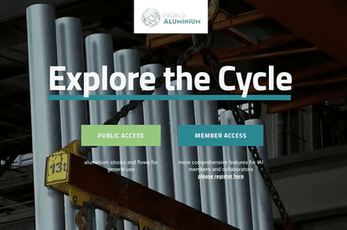Aluminium is extensively employed in buildings, but it does not remain permanently in place. Buildings are remodeled periodically, and even deconstructed, thereby freeing the aluminium for recycling. Therefore, it is not inaccurate to regard this aluminium as “urban ore” and cities as “urban mines”.
Ensuring that the material loop is closed is an essential element in the sustainability of transport aluminium. The value of aluminium, a function of the material’s unique properties and the energy required to produce primary metal, means that 90% of aluminium in automotives is collected and recycled at the end of its useful life.
ISO 14044 offers guidelines how to consider recycling in the life cycle of products. In the case of aluminium architectural products, which are not lost or consumed during the lifetime of a building, but only used and which are recycled an indefinite number of times (with some losses); there is no longer a “grave” or landfilling stage. They clearly fulfil the idea of a “cradle-to-cradle” approach. Aluminium building products are recycled without alteration of the metal’s inherent properties; therefore the best approach to improving resource efficiency is the intelligent design of applications that maximize the end of life recycling rate.
As stated in the “Declaration by the Metals Industry on Recycling Principles”, the recycled content concept has a limited environmental significance for metals, especially for aluminium which is systematically recycled.
The recycled content approach is a useful metric only for material where the energy and cost saved by recycling are relatively small compared to those of primary production. In practice, this means that these materials would otherwise be incinerated or landfilled as waste. In this case, targeting a percentage of recycled content has an environmental meaning since it stimulates a market for recycled materials that is otherwise limited, uneconomic or immature.
This approach does not apply to aluminium for which recycling technologies and markets are mature and profitable as reflected by the high value of aluminium scrap.Though collection rates for aluminium building applications were previously suspected to be high, no firm evidence existed to this effect until 2004, when the European Aluminium Association commissioned Delft University of Technology to investigate how much aluminium was actually present in a sample of six European buildings and, of this content, how much was recovered and recycled upon demolition. The collection rates were found to vary between 92% and 98% demonstrating aluminium’s pivotal role in the pursuit of full sustainability.
Housing a century’s worth of industry data, the IAI’s most comprehensive industry data set yet, is available here. Built on the aluminium industry’s data from 1962 – 2019 and demand scenarios to 2040, Alucycle presents almost two decades of Material Flow Analysis modelling. The site is interactive and enables regional analysis of the aluminium chain overtime. Members and collaborators can access the exclusive ‘Member Access’ area to access the data in various formats.

